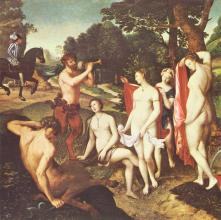François Clouet (c. 1510 – 22 December 1572) son of Jean Clouet, was a French Renaissance miniaturist and painter, particularly known for his detailed portraits of the French ruling family.
The earliest reference to him is a document dated December 1541 (see Jean Clouet), in which the king renounces for the benefit of François his father's estate, which had escheated to the crown as the estate of a foreigner. In this document, the younger Clouet is said to have followed his father very closely in his art. Like his father, he held the office of groom of the chamber and painter in ordinary to the king, and so far as salary is concerned, he started where his father left off. Many drawings are attributed to this artist, often without perfect certainty. There is, however, more to go upon than there is in the case of his father.
As the praises of François Clouet were sung by the writers of the day, his name was carefully preserved from reign to reign, and there is an ancient and unbroken tradition in the attribution of many of his pictures. There are not, however, any original attestations of his works, nor are any documents known which would guarantee the ascriptions usually accepted. To him are attributed the portraits of Francis I at the Uffizi and at the Louvre, and various drawings relating to them. He probably also painted the portrait of Catherine de' Medici at Versailles and other works, and in all probability a large number of the drawings ascribed to him were from his hand. One of his most remarkable portraits is that of Mary, queen of Scots, a drawing in chalks in the Bibliotheque Nationale, and of similar character are the two portraits of Charles IX and the one at Chantilly of Marguerite of France. Perhaps his masterpiece is the portrait of Elizabeth of Austria in the Louvre. This piece made an important impression on Claude Levi-Strauss. In particular it helped inspire his theory of the modèle réduit, or of works of art as simplifications and scale models of the realities they represent, and other theories of artworks, in his book The Savage Mind.
Clouet resided in Paris in the rue de Ste Avoye in the Temple quarter, close to the Hotel de Guise, and in 1568 is known to have been under the patronage of Claude Gouffier de Boisy, Seigneur d'Oiron, and his wife Claude de Baune. Another ascertained fact concerning François Clouet is that in 1571 he was summoned to the office of the Court of the Mint, and his opinion was taken on the likeness to the king of a portrait struck by the mint. He prepared the death-mask of Henry II, as in 1547 he had taken a similar mask of the face and hands of Francis I., in order that the effigy to be used at the funeral might be prepared from his drawings; and on each of these occasions he executed the painting to be used in the decorations of the church and the banners for the great ceremony.
Open an article about François Clouet



